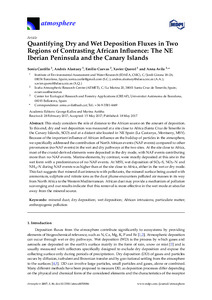Por favor, use este identificador para citar o enlazar este ítem:
http://hdl.handle.net/20.500.11765/6972
Quantifying dry and wet deposition fluxes in two regions of contrasting african influence: the NE Iberian Peninsula and the Canary Island
Registro completo de metadatos
| Campo DC | Valor | Lengua/Idioma |
|---|---|---|
| dc.contributor.author | Castillo, Sonia | es_ES |
| dc.contributor.author | Alastuey, Andrés | es_ES |
| dc.contributor.author | Cuevas Agulló, Emilio | es_ES |
| dc.contributor.author | Querol, Xavier | es_ES |
| dc.contributor.author | Ávila, Anna | es_ES |
| dc.date.accessioned | 2017-05-25T10:17:48Z | - |
| dc.date.available | 2017-05-25T10:17:48Z | - |
| dc.date.issued | 2017 | - |
| dc.identifier.citation | Atmosphere. 2017, 8(5), p. 1-17 | es_ES |
| dc.identifier.issn | 2073-4433 | - |
| dc.identifier.uri | http://hdl.handle.net/20.500.11765/6972 | - |
| dc.description.abstract | This study considers the role of distance to the African source on the amount of deposition. To this end, dry and wet deposition was measured at a site close to Africa (Santa Cruz de Tenerife in the Canary Islands, SCO) and at a distant site located in NE Spain (La Castanya, Montseny, MSY). Because of the important influence of African influence on the buildup of particles in the atmosphere, we specifically addressed the contribution of North African events (NAF events) compared to other provenances (no-NAF events) in the wet and dry pathways at the two sites. At the site close to Africa, most of the crustal-derived elements were deposited in the dry mode, with NAF events contributing more than no-NAF events. Marine elements, by contrast, were mostly deposited at this site in the wet form with a predominance of no-NAF events. At MSY, wet deposition of SO4–S, NO3–N and NH4–N during NAF events was higher than at the site close to Africa, either in the wet or dry mode. This fact suggests that mineral dust interacts with pollutants, the mineral surface being coated with ammonium, sulphate and nitrate ions as the dust plume encounters polluted air masses in its way from North Africa to the Western Mediterranean. African dust may provide a mechanism of pollution scavenging and our results indicate that this removal is more effective in the wet mode at sites far away from the mineral source. | es_ES |
| dc.description.sponsorship | Acknowledge the financial support from the Spanish Government (CGL2005-07543-CLI, CGL2009-13188-C03-01, CSD2008-00040-Consolider Montes grants and the “Subprograma MICINN-PTA” funded by the European Social Fund). The Global Atmospheric Watch program at the Air Quality Research Observatory at Santa Cruz de Tenerife has been funded by AEMET. The IDAEA group acknowledges the financial support of the Generalitat de Catalunya (AGAUR 2014 SGR33 and the DGQA) | es_ES |
| dc.language.iso | eng | es_ES |
| dc.publisher | MDPI | es_ES |
| dc.rights | Licencia CC: Reconocimiento CC BY | es_ES |
| dc.subject | Mineral dust | es_ES |
| dc.subject | Dry deposition | es_ES |
| dc.subject | Wet deposition | es_ES |
| dc.subject | African intrusions | es_ES |
| dc.subject | Particulate matter | es_ES |
| dc.subject | Anthropogenic pollution | es_ES |
| dc.subject | Polvo mineral | - |
| dc.subject | Material particulado | - |
| dc.subject | Contaminación antropogénica | - |
| dc.title | Quantifying dry and wet deposition fluxes in two regions of contrasting african influence: the NE Iberian Peninsula and the Canary Island | es_ES |
| dc.type | info:eu-repo/semantics/article | es_ES |
| dc.relation.publisherversion | http://dx.doi.org/10.3390/atmos8050086 | es_ES |
| dc.rights.accessRights | info:eu-repo/semantics/openAccess | es_ES |
| Colecciones: | Artículos científicos 2015-2018 | |
Ficheros en este ítem:
| Fichero | Descripción | Tamaño | Formato | ||
|---|---|---|---|---|---|
| atmosphere-08-00086.pdf | 2,08 MB | Adobe PDF |  Visualizar/Abrir |
Los ítems de Arcimis están protegidos por una Licencia Creative Commons, salvo que se indique lo contrario.





